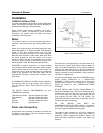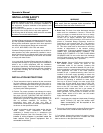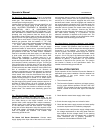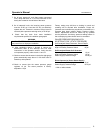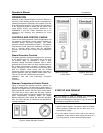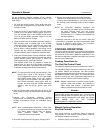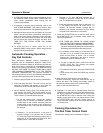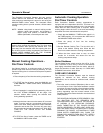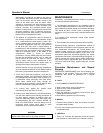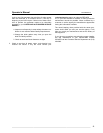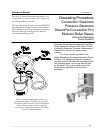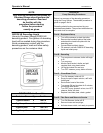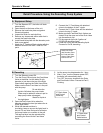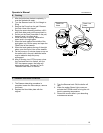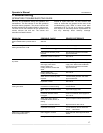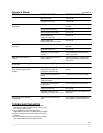
Operator’s Manual P/N-260AOZ-A
______________________________________________________________________________
11
When steam is produced, the water in the boiler is
being distilled. During this process, the minerals that
come into the boiler with the water; remain in the
boiler as the water boils away as steam. When
allowed to accumulate, the water becomes highly
mineralized, which results in erratic operation, lime
build-up, corrosion, and premature electric heater
failures. In some cases, complete boiler replacement
becomes necessary, which is extremely expensive.
By draining the boiler under pressure, most sediment
present will be flushed down the drain.
2. The steamer is equipped with a drain in the back of
the cooking compartment. No compartment should
be o~ crated without the drain screen in place. This
screen prevents large food particles from entering
and possibly plugging the drain line. Any restriction
of the drain line may cause a slight build-up of
backpressure in the compartment, resulting in steam
leaks around the door gasket. It also may adversely
affect the convection action of the steam in the
compartment, which is critical to optimum
performance. Pouring USDA approved drain cleaner
through the compartment drains once a week will
help to ensure an open drain. An auger or "snake”
may be safely used to clear obstructions in the
compartment drains. Do not use a power auger, as
damage to the plastic drain system will result.
With the steamer off, open the cooking compartment
doors and allows the steamer to cool before cleaning
the cooking compartments and their components.
3. At the end of each day's operation, wash the pan
slides door gaskets, and compartment interiors with
mild detergent and warm water, either by hand or in
a dishwasher Rinse thoroughly with clear water.
Rinse water should drain freely through the
compartment drain openings. If it does not, the drain
must be cleaned before using the steamer.
4. To prolong door gasket life, always leave
compartment door ajar when not in use.
5. Exterior Care: Allow steamer to cool before washing.
Use the same cleaners and cleaning procedures as
for other kitchen surfaces of stainless steel and
aluminum. Mild soapy water, with a dear water rinse,
is recommended. DO NOT ALLOW WATER TO
RUN INTO ELECTRICAL Controls. Always turn off
equipment power before using water to wash
equipment. Do not hose down the steamer!
WARNING
Do not store gasoline or other flammable vapors and
liquids in the vicinity of this or any other appliance.
MAINTENANCE
Periodically, a qualified serviceman should be summoned
for routine preventive maintenance.
1. The Blowdown procedure will not completely remove
the mineral deposits that adhere to the top of the boiler. A
boiler treatment specialist should do a chemical descaling.
This should be done 4 times a year in average water
conditions, but in poor water areas it may be needed more
often.
2. A qualified Field serviceman should make periodic
boiler inspections.
3. The cold water line strainer should be cleaned weekly.
Cleveland Range supports a comprehensive network of
Maintenance and Repair Centers (regional parts and ser-
vice distributors) throughout the United States and
Canada. Please contact your nearest distributor for the
name of an authorized service agency in your area, or for
replacement parts and information regarding the proper
maintenance and repair of Cleveland Range equipment. In
order to maintain the various agency safety certifications,
only factory-supplied replacement pans should be used.
The use of other than factory supplied parts will void the
warranty.
Preventive Maintenance and Record
Keeping
PREVENTIVE MAINTENANCE is the key to keeping your
equipment in top condition. There are certain cleaning
procedures that should be performed on a regular
schedule.
A. DAILY
1. Using a NON-CHLORINE DETERGENT
a. Wipe out the interior of the compartments
b. Wipe the face of the compartments
c. Rinse the pan slides
d. When the steamer is not cooking, leave the door open
resting against the door latch.
e. Wipe down the gaskets to prevent sticking
5. WEEKLY
1. Check the door gasket for wear and reverse or replace
the gasket when needed.
2. Pour a liquid chemical descaler down the back of each
compartment drain.
C. MONTHLY
1. Every 3 to 4 months the generator should be opened
and checked for mineral build up or Chloride corrosion.



